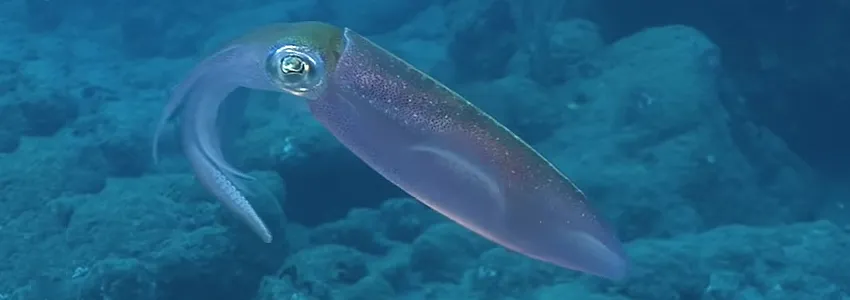
Screenshot from video: Squid can camouflage themselves through natural processes that manipulate light.
Stanford Engineering - July 5th, 2016 - by Vignesh Ramachandran
So much of what makes our planet tick and makes humans thrive is based on light – which is exactly why a Stanford professor is determined to control it.
Jennifer Dionne, assistant professor of materials science and engineering, is a leader in the field of nanophotonics – dealing with structures that are about 10 times smaller than the size of a virus. She and her graduate students are focused on developing new methods to control the interaction of light with materials.
“Once you have the ability to control light and use it to visualize things happening from the nanoscale to the macroscale, you then have the ability to better control phenomena – whether in health and medicine, renewable energy, or information processing,” Dionne said.
A recent Stanford magazine profile traces the arc of Dionne’s career. After completing her undergraduate studies in physics and systems science and mathematics at Washington University in St. Louis, doing oceanography research at the University of Rhode Island, earning her master’s and PhD degrees in applied physics from the California Institute of Technology, and doing postdoctoral work in chemistry at the University of California, Berkeley, Dionne joined the Stanford faculty in 2010 at the age of 28.
Since then her lab has worked on a number of novel applications in nanophotonics, including the development of synthetic squid skin. “Squid have the amazing ability of being able to camouflage themselves to match almost any background in their environment,” Dionne explained. Could invisibility cloaks become a technological possibility?
Other applications could lead next-generation information technology products: Controlling light on the nanoscale would allow engineers to replace today’s electronic circuits with optical circuits. This would allow computation using less energy that truly moves at the speed of light.
Her group is also working on optical trapping and optical manipulation. By using focused laser beams, she is trapping and manipulating nanoparticles and proteins. This technology has applications in detecting and directing the motion of biomolecules that determine cellular function and fate, as well as in the development of new water purification technologies.
Another focus is on energy generation and storage, understanding and improving how solar cells and batteries work. One watchword here is “upconversion” -- finding ways to use more of the light spectrum in order to harvest more energy from photovoltaic cells and photocatalytic cells.
Driving it all is a restless quest to peel back the layers of mystery around nature’s incredible gifts, such as light. “I think the wellspring of scientific curiosity is the desire to always learn more,” she said.
Among other accolades, Dionne has received a Presidential Early Career Award for Scientists and Engineers; been named a Sloan Research Fellow in 2015; earned a spot on MIT Technology Review’s “Innovators Under 35” list; and a tip of the hat on Oprah’s list of “50 things that will make you say ‘wow!’”

